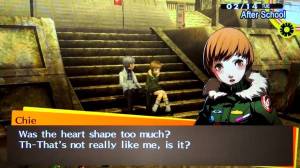RPG Design: An Imperfect Union
Posted by Rampant Coyote on December 19, 2014
When this article posts, I should be in the air with most of the Pacific Ocean behind me, on my way back from Japan. Didja miss me? Didja even notice I was gone?
 Spending a week and a half in the Land of the Rising Sun kinda made me want to play Persona 3 and Persona 4 again. Maybe it’s all the kids in school uniforms and being able to buy Octopus Jerky. Not that I have actually bought the stuff, mind you… it’s just available. The little Japanese culture references in those games – which probably aren’t even conscious references by the designers – make the games stand out a little in my mind. Dang those were good games.
Spending a week and a half in the Land of the Rising Sun kinda made me want to play Persona 3 and Persona 4 again. Maybe it’s all the kids in school uniforms and being able to buy Octopus Jerky. Not that I have actually bought the stuff, mind you… it’s just available. The little Japanese culture references in those games – which probably aren’t even conscious references by the designers – make the games stand out a little in my mind. Dang those were good games.
I managed to do a little bit of RPG playing during this trip (though it’s been pretty busy…). I had a total party wipeout in Wizardry 6 (since I had only one, you can infer correctly I didn’t play a lot of it), re-explored more of the gigantic basement of Lord British’s castle in Ultima Underworld 2, got cracking with a deadly spoiled brat in Loren the Amazon Princess, and revisited my old standby Din’s Curse for some quick hacking and slashing. I expected to get really serious about Dead State once I get home.
As I’ve been dividing my productive time between fiction writing and game development, I’ve once again been mixing and matching lessons from each creative endeavor. As writing is a far older, more popular, and far more developed field, there is a greater quantity of useful (and useless) information available on the subject. I found myself reading about the development of first chapters of a novel, and immediately considered the applicability in computer role-playing games.
In principle: Lots. In implementation: Iffy.
In the early 90s, there was a pretty clean delineation between “Western” RPGs (wRPGs) and Japanese RPGs (jRPGs). The jRPGs really started taking advantage of solid storytelling technique, and their popularity soared. Meanwhile, for a while, the wRPGs kind of went into a popularity decline, as the storyline of “Hey, dungeon! Beat it!” didn’t compare too well, even though the dungeons were becoming really pretty dang cool and interactive.
We still end to use those distinctions, although the styles of games have probably had more in common for much longer than they were really separate. Unfortunately, some of the wrong lessons were learned (IMO) – both styles of games accrued insufferably long intro sequences before the player is allowed significant interaction (and as much as I praise the Persona games, yeah, they are like that, but hardly the worst offenders), and clicky-actiony interaction masquerading as gameplay (because keeping the player busy leaves them less time to think about how the gameplay sucks, I guess).
It sometimes feels like we kicked the happy medium to the roadside.
Of course, I’m exaggerating, especially when it comes to the slew of cool indie and “big indie” RPGs that have been released lately. While there’s still plenty of room for improvement, there’s at least a sense that they’ve learned the right lessons.
Narrative and gameplay form an imperfect union. Simply put – players play to win the game, not to make better dramatic choices, which spoils the narrative; but forcing those dramatic choices upon the player spoils the interactivity and gameplay. However, those competing forces can be carefully balanced to form something really cool. Maybe it cannot be the best story in the world or represent perfect gameplay, but it can be something greater than the sum of its parts. The two competing elements can enhance the flavor of their counterparts.
Filed Under: Design - Comments: Comments are off for this article